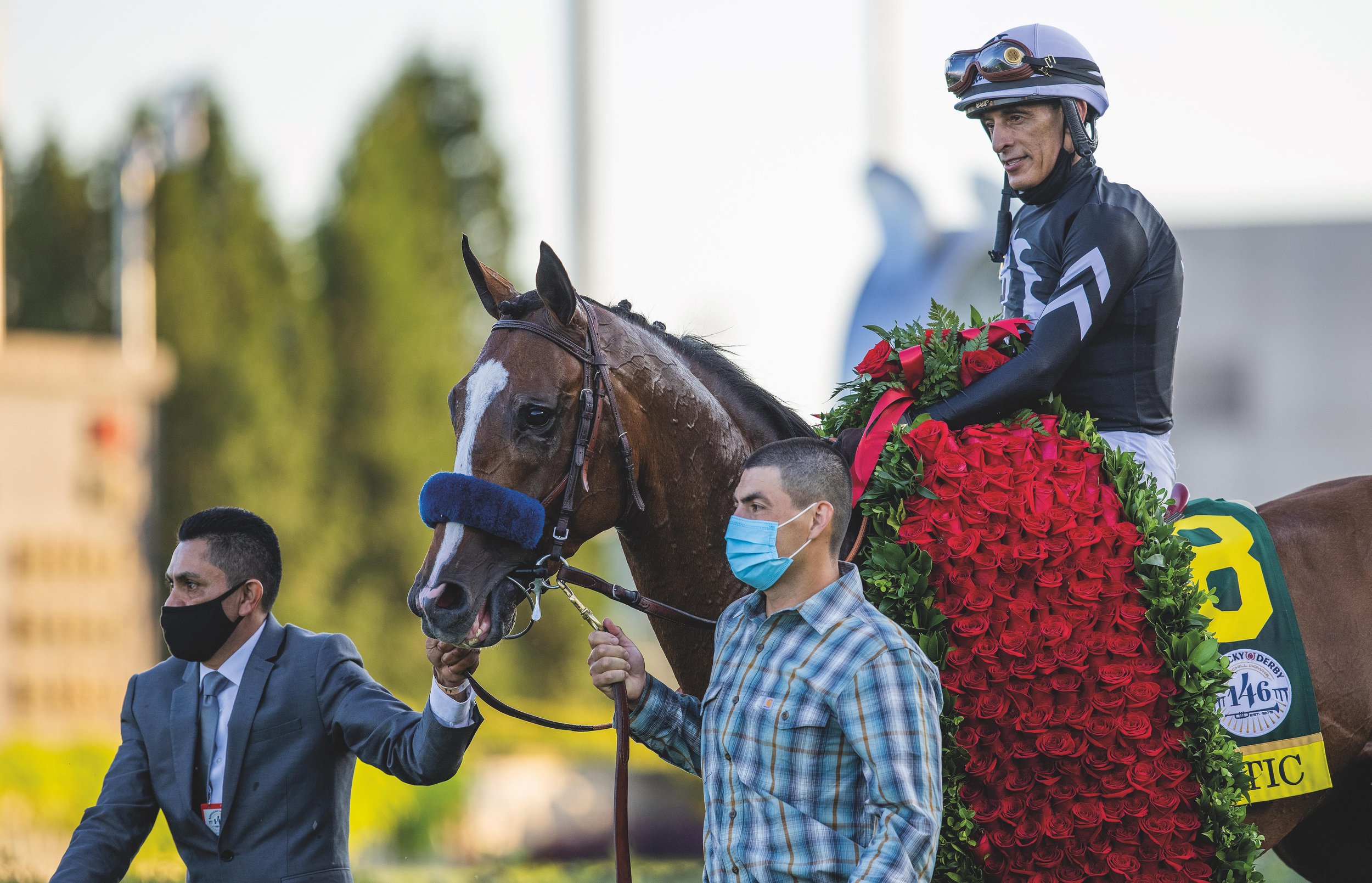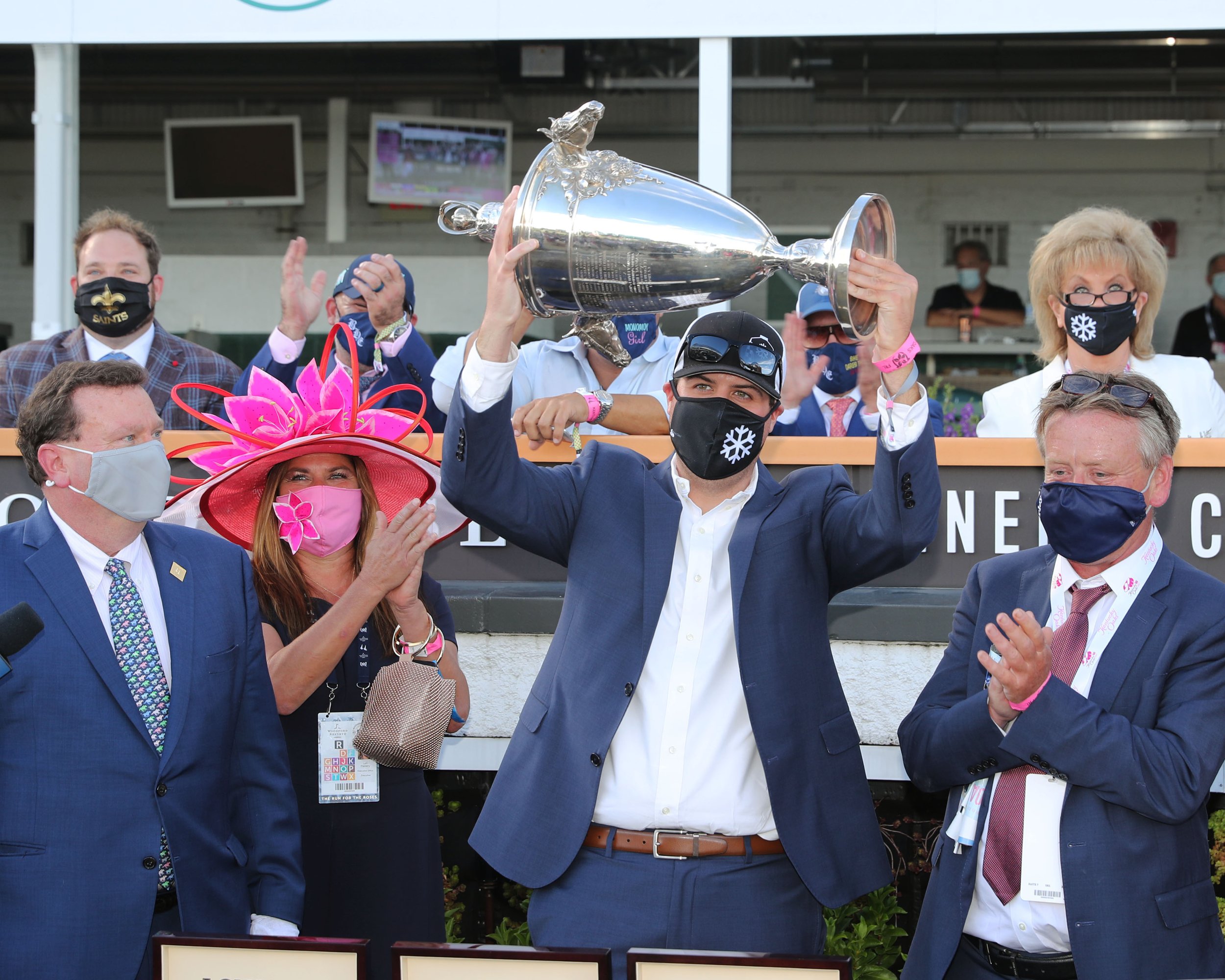The ownership team of Hard Not to Love stretches from West Point Thoroughbreds in New York to Dottie Ingordo Shirreffs, the wife of trainer John Shirreffs, in California. This one-eyed wonder captured the Grade 1 La Brea Stakes December 28 by 2 ¼ lengths and the Grade 2 Santa Monica February 15 by 3 ½ lengths with a magnificent three-wide sweep past horses she couldn’t even see with her lone right eye. On her latest start, she ran a gallant second behind Ce Ce in the Grade 1 Beholder Mile at Santa Anita.
The ownership team also includes Shirreffs’ son David—an accomplished pinhooker in Kentucky, F. Steve Mooney—an owner of a mine company in Denver, Ed Moody—a video gaming designer in Las Vegas, and Scott Dilworth—a pinhooker in Texas.
They are united by the accomplishments of their amazing four-year-old filly, a half-sister to 2018 Queen’s Plate winner Wonder Gadot, whose only loss in six starts was a third in a stakes as a two-year-old in May 2019. Hard Not to Love may not have the immense talent of the Sherriffs’ massive 2010 Horse of the Year Zenyatta—the horse of a lifetime who won 19 of 20 starts—but she may be getting just as much love with plenty of racing left despite losing her left eye in a training accident after the ownership group purchased her for $400,000 as a yearling at Keeneland in September 2017. She was one of six purchases the group bought at that sale. Two of the other five are Carressa, who won the Grade 3 Megahertz Stakes, and Blue Norther Stakes victor Giza Goddess in her turf debut.
David Ingordo
Asked if he’s getting tired of people asking him about Hard Not to Love, David Ingordo laughed, “If I get tired of talking about her, I should be out of the business. To have a horse like her is an honor. It’s what everybody in the business works for.”
Now 43, he began working at the racetrack on his 14th birthday as a hotwalker for Hall of Fame trainer Bobby Frankel through a special license his parents procured. His late father, Jerry Ingordo, was a jockey agent for Laffit Pincay Jr., Sandy Hawley and Patrick Valenzuela. “He passed away when I was 21,” David said. “We were very close.”
David is also close to his stepfather. “I introduced my mother to John Shirreffs,” he said. “I chaperoned her first date with him. We’re all very close.”
David became the youngest assistant trainer in the country when he was 18, then attended the University of Kentucky while working mornings at Juddmonte Farms. He worked for Walmac International for five years, quickly becoming the head of their bloodstock development before opening his own management and acquisition agency, Ingordo Bloodstock Services.
Among the horses he has purchased are Zenyatta for Jerry and Ann Moss, Stellar Wind, Honor Code, Ball Dancing, Gormley, Wicked Style, Majesticperfection, Personal Rush, Crisp, Switch, Mona de Momma and Uncle Mo.
He patched the Hard Not to Love group together. “We were looking to put a group together,” he said. “A few people said, `Give us a chance.’ People want to have horses for John Shirreffs. It’s a rare thing for people like us to put in their own money to support John. There is no better horseman in the country, in the world, than John Shirreffs. Bobby Frankel said to me, that John is the best trainer in the world. He’s patient. He doesn’t have the super stable, but he’s a tremendous horseman. The horse is first. If he can’t do it, nobody can. He’s that gifted. I don’t think he gets the credit he deserves. He’s involved with the horse at a different level, but he’s very humble about it. Zenyatta was too big to stay in training. She had too many problems. John is a brilliant guy.”
He also admires his mother: “She was one of the first female racing managers. She’s a brilliant woman. We’re all individuals. There’s no nepotism in our family. If you don’t cut it, you can go work for Starbucks.”
Scott Dilworth
Born in San Antonio and raised on a ranch, Scott Dilworth made his name in livestock insurance before turning to pinhooking in 2005. “I’m a trader, and I love to trade,” he said.
He ran into David at Saratoga. “We talked about creating a partnership together and buying some fillies, with hopefully getting stakes horses, then reselling them,” Scott said. “I really wasn’t that interested in racing them. I was interested in selling them.”
That changed. Hard Not to Love became his first Gr1 stakes winner. “When you win a Gr1, you’re going to like racing,” Scott said. “She was a handful at the sale. She’s always been pretty fractious. The McKathan brothers did a heck of a job getting her ready. She would freeze on the track. They finally got her off to John Shirreffs. John is the only person in the world who could get her to where she is today. John had a ton of patience with her. It was quite an experience.”
It still is. “Three of the six horses we purchased are stakes winners,” Scott said. “All credit to David and John.”
Steve Mooney
Mining has been F. Steve Mooney’s livelihood; horses have been his passion. “My wife Gayle and I have been involved in horses for a long time,” he said. “My daughter showed horses.”
After graduating from the Colorado School of Mines with a degree in geological engineering, Steve worked for the Utah Mining Company, the U.S. Borax Corporation in New Mexico and then with the Gulf Oil Corporation for 18 years, becoming an executive vice president. After Gulf merged with Chevron, he joined Cyprus Minerals Company, becoming president. He formed the Thompson Creek Metals Company, Inc. and is currently the CEO, living in Denver. Among many honors, he was awarded the Distinguished Achievement Medal by the Colorado School of Mines and won the American Institute of Mining, Metallurgical and Petroleum Engineers (AIME) William Lawrence Saunders Gold Medal.
His business success has allowed him to own Thoroughbreds. “Through a mutual friend, we got to know Will Farish,” he said. “We’ve had some mares at Lanes End, gone through selling yearlings and kept a couple.”
One of his keepers was one of David’s major sales, Ball Dancing. She gave Steve his first Gr1 victory by taking the Jenny Wiley at Keeneland on April 11, 2015. The horse who finished third in the race was Hard Not to Like.
Steve went from beating Hard Not to Like to owning Hard Not to Love. “We’ve got involved with the Shirreffs and David four or five years ago through our contact with the Farishes,” Steve said. “It’s a great story. I think John Shirreffs ought to get Trainer of the Year for bringing her along the way he did. I give all credit to John for that. I’ve really enjoyed getting to know John and Dottie.”
Ernie Moody
Born in Elizabeth, N.J., and now living in Las Vegas, Ernie Moody is a video game designer. “I designed video poker and invented Triple Play Poker,” he said. ”I got a patent on that, and I was making so much money, I needed a way to get rid of excess cash.”
Hello horse racing. “I did a great job of getting rid of that excess cash,” he laughed.
Ernie races in the name of Mercedes Stable, named for his girlfriend, Mercedes. They’ve been involved in some major partnerships, including Madeleine Paulson on Rock Hard Ten and former New York Yankees Manager Joe Torre on Game On Dude. “He won the Santa Anita Handicap three times,” he said. “Unfortunately, he was a gelding.”
Hard Not to Love is a filly. “We just got involved with John,” Ernie said. “She is an amazing horse.”
Dottie Ingordo
How did Dottie go from teaching third and fourth grades to becoming a racing manager? “I’ve been around the business my entire life,“ she said. “David’s father was a jockey agent, so that was our whole life. We used to have handicapping contests at our house. I’d get the Form and start handicapping.”
Dottie and Jerry Ingordo became close friends with Bobby Frankel, who told Harry Silbert—Bill Shoemaker’s longtime agent—that he needed help with his stable. So Harry asked Dottie, who told him she had a career in teaching. But she and her friend Allison developed a job-sharing program and suddenly, her workload wasn’t the same.
“After about two or three years of asking, I became Bobby’s racing manager,” Dottie said. Then, on a Saturday morning at Del Mar, Dottie got a call from owner Jerry Moss. Moss needed help with his stable, and as Dottie put it, “One thing led to another.” She became Moss’ racing manager, “It was a little intertwined,” she said.
She had no idea how intertwined her life would become. Jerry wanted to hire a new trainer. John Shirreffs’ biggest client, John Mabee, had died. David called up his mom and suggested interviewing John. “Jerry and I interviewed John in 2000,” she said.
That must have been one hell of an interview. Dottie not only hired John but wound up marrying him in 2003. “We laughed at how many times we were in the paddock without knowing each other,” she said.
Dottie had a wonderful time watching Zenyatta become one of the greatest horses in racing history. “Zenny—she was a blessing,” Dottie said. “She came at a time when the sport needed her. John was the right one for her. He’s incredibly patient.”
He had to be with his huge filly: 17.2 hands and 1,217 pounds named for the album Zenyatta Mondatta by The Police, who were signed to A&M Records by Jerry Moss. She was 19-for-19 before losing her final start of her career by a short head to Blame in the 2010 Breeders’ Cup Classic, a year after she became the lone filly to win the Breeders’ Cup Classic.
Zenyatta’s nuances were nothing compared to the impairment of Hard Not to Love. “We love her—are you kidding?” Dottie said. “She’s very special. She had a little glitch at the training center. These people tried everything to save her eye. It caused her to make adjustments of course. She’s handled it with such grace. You have to be patient with her.”
And inventive. “John has a mirror in her stall,” Dottie said. “She thinks she’s with another horse. John came up with it. It’s a very clever idea. She travels with it. It’s comforting. You have to do a lot of things.”
Her groom, Martin, walked her all the way out on the track for her last start. “He started crying,” Dottie said. “He loves her. I think she’s symbolic for racing. It shows that in life, things can happen. It’s how you handle it.”
How does Dottie handle being partners with her son? “He’s a great partner,” she laughed. “Fabulous. It’s cute. It’s a lot of fun. We have a lot in common. It’s great when your child becomes your friend. We never run out of things to talk about. We have a lot of fun.”
John Shirreffs
Asked about this ownership group, John said, “It’s a very diverse group. We’re having a lot of fun with Hard Not to Love. Everybody has been pretty patient. You never know what the boundaries are with Thoroughbreds because they’re such athletes. They can do so many things.”






















